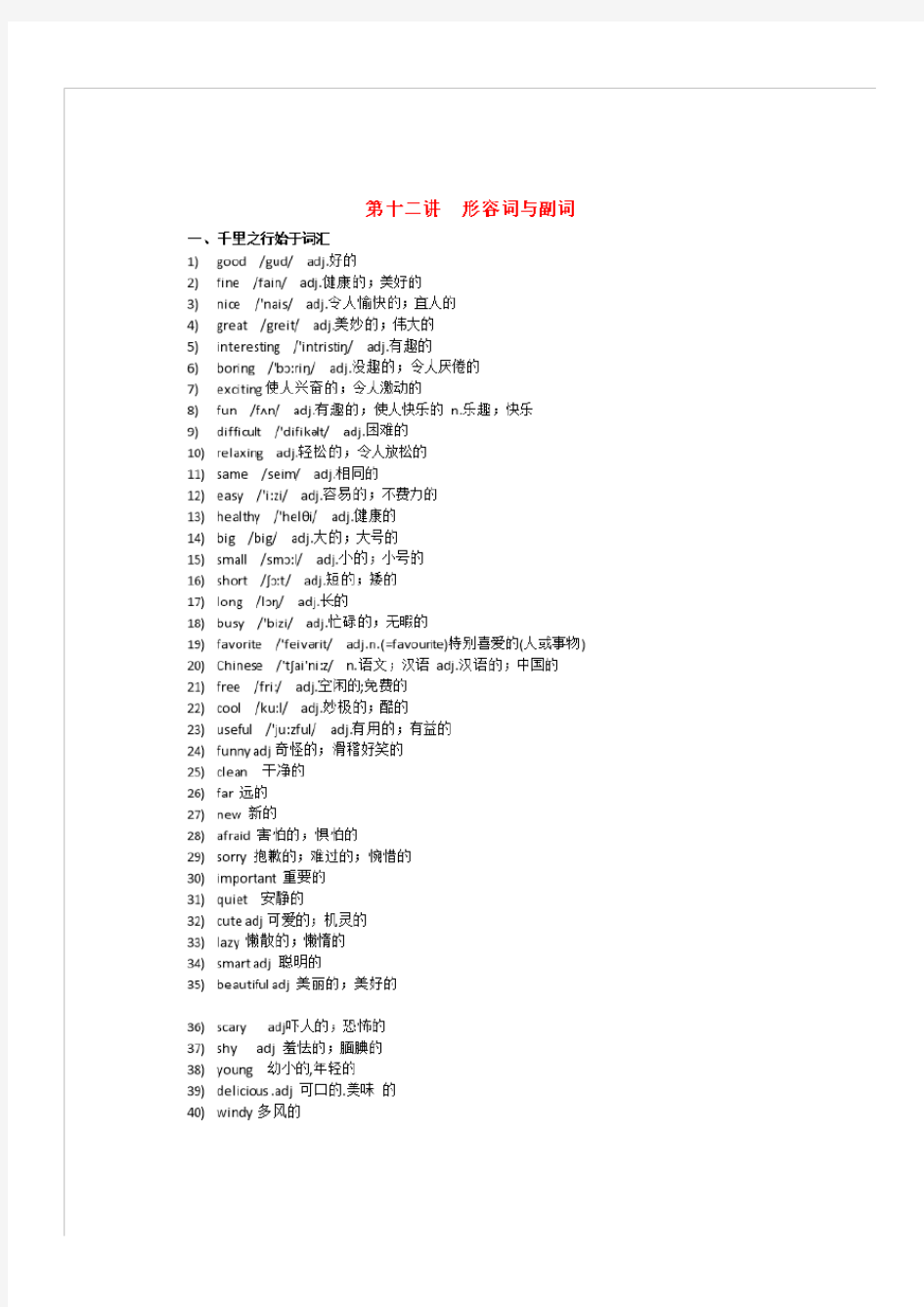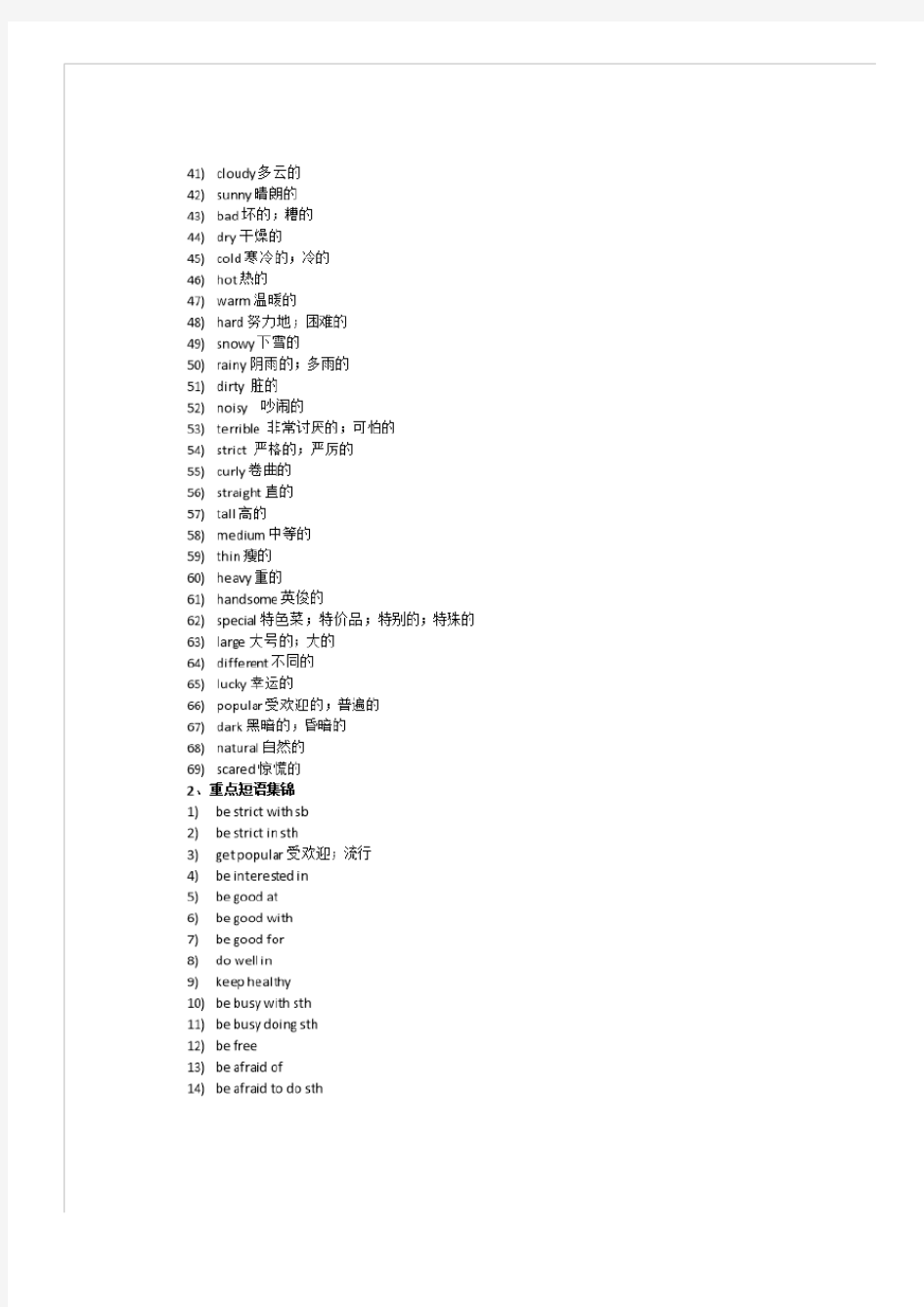

2020年高考英语专题12 形容词和副词 【2020年】 1.(2020·新课标I卷)Landing on the moon’s far side is 62 (extreme) challenging. 【答案】extremely 【解析】考查副词。句意:登录月球的背面是极其有挑战性的。空处修饰形容词challenging,应使用extreme的副词形式,故填extremely。 2.(2020·新课标I卷)Data ab out the moon’s composition, such as how69 ice and other treasures it contains, could help China decide whether its plans for a future lunar (月球的) base are practical. 【答案】much 【解析】考查形容词。句意:关于月亮构成的数据,比如它含有多少水和其他财富,可以帮助中国决定它未来月球基地的计划是否实用。ice是不可数名词,应使用much修饰,故填much。 3.(2020·新课标I卷)Today I tried cooking a simply dish myself. 【答案】将simply改为simple 【解析】考查形容词。句意:今天我自己尝试做一道简单的菜。根据名词dish可知,此处应用形容词作定语,故将simply改为simple。 4.(2020·新课标II卷)Bamboo: Chinese love their “Lucky Bamboo” plants and you will see them often in their homes and office. 66 (certain) during the holiday period, this plant is a must. 【答案】Certainly 【解析】考查副词。句意:当然在假期期间,这种植物是绝对必要的事物。介词短语做时间状语,因此只有改变成副词才能复合句子结构,用副词形式做状语。故填Certainly。 5.(2020·新课标II卷)The 69 (beauty) long branches covered with pink-colored buds (蓓蕾) make fantastic decorations. 【答案】beautiful 【解析】考查形容词。句意:美丽的长枝上覆盖着粉红色的花蕾,做成漂亮的装饰。修饰名词branches,用形容词形式。故填beautiful。 6.(2020·新课标II卷)I’m surely you’ll have a good time. 【答案】将surely改为sure 【解析】考查形容词。句意:我相信你会玩得很开心的。分析句子,此处be动词am后面需用形容词作表语。故将surely改为sure。
小升初英语形容词、副词(一) 复习 一、 WherewhatwhosewhenwhyhowWho 1.______________book is it?It’s mine. 2._____________is the Christmas Day?It’s on the December 25th. 3._____________is the pen?It’s under the desk. 4.____________is the dress? It’s blue. 5._____________is the boy in green?He’s Mike. 6._____________day is it today?It’s Monday. 7.______________color do you like best?Red. 8._______________is your sister?He’s 15 years old. 9._______________is this yellow one?It’s beautiful. 10._______________are you late for class?I am sick. 11._________________is the pen?---Ten yuan. 12.________________boys? ---Three boys.选词填空 whichwhat colorhow oldHow muchHow many 二、对划线部分提问 1.This is a photo. _________________________________________________________________ _____________________________________________________________________ ________________________________________
语法复习专题四——形容词和副词 备考建议: 1.从几年来收集到的题目中可以看出高考对形容词和副词的考查主要集中在以下两点: (1)形容词的比较级和最高级; (2)在具体语境中辨析形容词和副词语义。 另外,考查形容词作定语时的语序问题的试题也不少。 2.对于比较级的考查,淡化结构,注重深层语义。“比较”的意思并不是直接能从“结构”中看出来的,而是从语句的深层意义中挖掘出来的。 3.在加强考查词义辨析的题目中,高考不但加强了对语义的考查(而不仅仅是语法),随着新教材词汇量的增大,而且注重对词汇扩展能力的考查。 要做好各类有关形容词和副词的试题应从这几方面去努力: 1.对单音节形容词和副词的比较级和最高级的构成、双音节和多音节的形容词及副词的比较级和最高级的构成,要加强记忆、找出其中规律;灵活掌握修饰比较级和最高级的副词和一些短语。 2.对某些副词的词义还需进一步认识,多数形容词在加-ly后,词义基本不变,而有些则不同,如:hard—hardly. 3.加强形容词、副词比较级考点的学习与应用,尤其是比较级在某些特定结构中的特殊含义,比较级及其修饰语的搭配和用法。巧记名词前多个形容词的排列顺序,形容词、副词等在不同语境下的辨析,要不断地提高分析试题的能力,克服思维定势,灵活运用所学的知识。 (1)加强对比较级和最高级表达法的学习,尤其是一些常见的句型,要做到张口能诵的程度。在理解上,不能留任何疑点。 (2)加强对形容词和副词的词义和用法的学习,要做到“词不离句,句不离义”。做题时,要结合语境,注意惯用法和固定搭配认真辨析从而做出最佳选择。 (3)判断句子成分,如果是作定语、表语等,一般是用形容词;如果是作状语、修饰谓语动词或形容词和副词,一般应用副词。但注意也有特殊情况,如形容词(短语)可作伴随或结果状语。 (4)分清句子结构,看看该句应该用原级、比较级还是最高级。 (5)注意特殊的含有形容词比较级的句型。 考点聚焦 1、形容词、副词的作用与位置 形容词是用来修饰名词的,常被放在名词前作定语,或放在系动词后面作表语。而副词则用来修饰形容词、动词,其他副词或者句子,一般位于形容词之前,动词之后或句子之首。以下属几种特殊情况,须牢记; (1)形容词短语作定语,定语后置。如:a language difficult to master (2)表语形容词(afraid、alike、alone、asleep、awake、alive等)作定语,定语后置。如a man alive。有些表身体健康状况的形容词如well、faint、ill只作表语。sick 既可作表语又可作定语,ill如作定语意为“bad”。 (3)用作定语,修饰由不定代词one、no、any、some和every构成的复合词如anything、something等时,通常后置。如:I have something important to tell you.
小升初英语形容词、副词(一) 知识点 一、形容词副词 1.形容词: 形容词(adjective),简称adj.很多语言中均有的主要词类中的一种。主要用来修饰名词的词,表示事物的特征。形容词用来修饰名词或代词,表示人或事物的性质、状态,和特征的程度好坏,与否. 例:Tom is my good friend. He is tall. She is beautiful. 2.副词 副词在句子中修饰动词,形容词,副词或整个句子。用来说明动作或状态的特征,时间,地点,程度,方式等情况。 1)副词按其用途和含义可分为下面五类: ?时间副词:时间副词通常用来表示动作的时间。 常见的时间副词有:now ,today, tomorrow, early。 He often comes to school late. What are we going to do tomorrow? ?地点副词:地点副词通常用来表示动作发生的地点。 常见的地点副词有:here, there, home, down, up, off, on, in, out等。: I met an old friend of mine on my way home. ?方式副词:方式副词一般都是回答“怎样的?”这类问题的。 常见的方式副词有:badly, carefully, suddenly, happily, slowly, well, fast, The old man walked home slowly. Please listen to the teacher carefully. ?程度副词:程度副词多数用来修饰形容词和副词,有少数用来修饰动词或介词短语。 常见的程度副词有:much, (a) little, a bit, very, so, too。
高中英语形容词和副词(高频汇总)
精品文档 高考英语高频形容词和副词 1.immediate adj立即的,即刻的;立刻的,马上 2.clear adj 清楚的,清晰的 3.cautious adj小心翼翼的 4.vivid adj 生动的,逼真的 5.exactly adv1.确切地,精确地;完全地 2.恰好地,正好地 6.fortunately adv.幸运地 3. (用于答语)完全正确。(的确这样) 7.surprisingly adv令人惊讶的 8.hardly adv 几乎不 9.instead adv代替,相反 10. properly adv 适当地;正确地;恰当地 11. specially adv专门 12.reliable adj 可靠的,可信赖的 13.simply adv 简单地;仅仅,只不过 https://www.doczj.com/doc/184589787.html,ly adv即,也就是 15.not nearly = far from = nowhere near远非,远远不,一点也不 16.patient adj耐心的;n 病人17.plain adj简单的,朴素的 18.familiar adj熟悉的; 19.lucky adj 幸运的 20.amazing adj令人惊异的, 21.accidentally adv 1. 偶然地;意外地 2. 附带地22.silent adj沉默的 23.calm adj平静的 24.secret adj 秘密的 25.otherwise adv 否则 26.meanwhile adv期间,同时 27.besides adv除…..以外还有 28.efficient adj高效的,有效的 29. flexible adj 灵活的 https://www.doczj.com/doc/184589787.html,plex adj复杂的 awkward adj 尴尬的,笨拙的 clumsy complicated adj 难懂的,复杂的 31.smooth adj平稳的,光滑的,顺利的 32.regularly adv 定期的,有规律的 33.sensitive adj 敏感的,体贴的 34.honest adj诚实的 35.confident adj自信的 36.shy adj .1.害羞的,腼腆2.羞涩的 37.thoughtful adj 1. 深思的,沉思的 2. 富有思想的;经认真推敲的 收集于网络,如有侵权请联系管理员删除
小升初形容词副词Revised on November 25, 2020
形容词和副词 一.形容词 1.修饰名词,描述其性质、品质、特征等的词。一般“…的”的词都是形容词。 如:She is a beautiful girl. (漂亮的) 2.在句中作定语、表语、宾语补足语。 如:I have an interesting book. (interesting有趣的,修饰book,在句中作定语) We are happy today. (happy快乐的,在句中作表语) Students should keep their classroom clean and tidy.(clean干净的,tidy整洁的, 在句中都作宾语补足语) 3.多个形容词同时修饰一个名词时的排列顺序 限定词+外观类+形状+年龄+颜色+国籍+材料+名词(简记:县官行令色国才) 如:a tall 17-year-old black American boy. 一个17岁的高个子黑皮肤美国男孩。 the big round red wooden table. 又大又圆的红色木质饭桌。 二.副词: 1.通常修饰动词,表示动作的程度、方式等。还可修饰形容词、副词,有时修饰整个 句子,在句中作状语。一般“…地”的词都是副词。 如:You must listen to the teacher carefully.(仔细地,认真地) 2.副词的分类 1) 时间副词: now, today等 2)频度副词:always, usually, often, sometimes, seldom, never 2) 地点副词:here, there, upstairs, downstairs等 3) 方式副词:carefully, fast, well, politely等 4) 程度副词: much, little, quite等
形容词与副词专项训练(一) 一、写出下列形容词或副词的比较级与最高级形式。 、用所给单词的正确形式填空 1.Which is _______ (easy) to learn, fishing or swimming? 2.It makes _______ (little) time to go to Beijing by plane than by train. 3.This T-shirt is too small for me. Would you buy me a _______ (large) one? 4.Xi ' an is one of ________________ (old) capital in China. 5.It will be bad for your health to eat ___________ (much) food and take _________ (little) exercise. 6.I think English is ______________ (useful) than before. 7.The Great Wall of China is one of ____________ (great) wonders in the world. 8.She is becoming ____________ (beautiful) than before. 9.The weather is getting _______ and _______ (cold). 10.The ________ (much) you practice, the _______ (easy) it becomes. 三、单项选择。 1.My sister is getting ____
形容词和副词讲义及演练 一.形容词 1.修饰名词,描述其性质、品质、特征等的词。一般“…的”的词都是形容词。 如:She is a beautiful girl. (漂亮的) 2.在句中作定语、表语、宾语补足语。 如:I have an interesting book. (interesting有趣的,修饰book,在句中作定语) We are happy today. (happy快乐的,在句中作表语) Students should keep their classroom clean and tidy.(clean干净的,tidy整洁的,在 句中都作宾语补足语) 3.多个形容词同时修饰一个名词时的排列顺序 限定词+外观类+形状+年龄+颜色+国籍+材料+名词(简记:县官行令色国才) 如:a tall 17-year-old black American boy. 一个17岁的高个子黑皮肤美国男孩。 the big round red wooden table. 又大又圆的红色木质饭桌。 二.副词: 1.通常修饰动词,表示动作的程度、方式等。还可修饰形容词、副词,有时修饰整个句 子,在句中作状语。一般“…地”的词都是副词。 如:You must listen to the teacher carefully.(仔细地,认真地) 2.副词的分类 1) 时间副词: now, today等 2)频度副词:always, usually, often, sometimes, seldom, never 2) 地点副词:here, there, upstairs, downstairs等 3) 方式副词:carefully, fast, well, politely等 4) 程度副词: much, little, quite等 5) 疑问副词: how, when, where, why等 三.形容词转化成副词 1.一般在形容词后加ly, 如:quick-quickly 2.以辅音字母+y结尾的形容词,变y为i, 加ly, 如:happy-happily 3.以ue 结尾的形容词,去e加ly, 如:true-truly 注:有些词兼有形容词和副词的词性,如:fast, hard, high, late, far等,它们的词性只有通过具体语境来判断。另外,有些以ly结尾的词不是副词,而是形容词,如:friendly, lovely lonely, lively等。 四.形容词和副词的比较级、最高级构成 1.比较级:两者之间进行比较时形容词和副词的变化形式,如tall-taller, well-better 2.最高级:三者或三者以上进行比较时形容词和副词的变化形式,如long-longest 3.比较级和最高级的变化规则: 规则变化(单音节和少数双音节): a.在词尾直接加-er/est, 如:short-shorter-shortest b.词尾是e,只加-r/st, 如:nice-nicer-nicest c.以辅音字母+y结尾的,变y为i 再加-er/est, 如:happy-happier-happiest d.重读闭音节,末尾只有一个辅音字母,双写该辅音字母,再加-er/est, 如:big-bigger-biggest e.其他双音节词和多音节词,其前加more/most, 如:more/most delicious 不规则变化:如下表(简记为:好、坏、多、少、远)
2017高考英语重点语法: 高考英语常考语法总结——形容词和副词形容词、副词是每年高考必考点之一,近几年语境综合化程度越来越高,难度加大。高考热点有:形容词、副词词义辨析;原级、比较级、最高级的使用;倍数的表达方法;比较等级的修饰语;多个形容词的排列顺序;常见形容词、副词的惯用法等。 关于形容词与副词这一考点,主要考查以下几个方面: 1. 考查形容词和副词的基本用法 形容词在句中一般作定语、表语、补语,而副词在句中主要作状语。 2. 考查形容词作定语的后置规律 形容词作定语一般位于所修饰的名词前,但下列三种情况形容词要后置: ①形容词短语作定语时;②表语形容词作定语时;③修饰复合不定代词时。 3. 考查多个形容词作定语的排序 多个形容词修饰名词时,其排序规律是:(限定词+程度副词+) 描绘+大小(长短、高低)+形状+年龄(新旧)+颜色+国籍或产地+物质材料+类别或用途+名词。 4. 考查副词在句中的位置规律 副词修饰形容词或其它副词时,一般位于被修饰词的前面,但enough却要放在被修饰的形容词或副词的后面。 5. 考查–ed形容词和-ing形容词的区别 -ed形容词,通常说明人,意为“(某人)感到……”;-ing形容词通常说明事物,意为“(某事物)令人……”或“令人……的(事物)”。 6. 考查两种不同形式的副词的用法差异 即考查与形容词同形的副词与形容词后加ly构成的副词的区别。 7. 考查形容词和副词的比较等级。 8. 考查比较等级的修饰语。 考点1:在具体的语境中辨析形容词与副词的语义 从复现的频率来看,此点是高考对形容词、副词考查的第一大热点。解答此类题关键是要分析具体的语境,结合基本词义、搭配等来选择正确的答案。
形容词和副词 一.形容词 1.修饰名词,描述其性质、品质、特征等的词。一般“…的”的词都是形容词。 如:She is a beautiful girl. (漂亮的) 2.在句中作定语、表语、宾语补足语。 如:I have an interesting book. (interesting有趣的,修饰book,在句中作定语) We are happy today. (happy快乐的,在句中作表语) Students should keep their classroom clean and tidy.(clean干净的,tidy整洁的,在句中都作宾 语补足语) 3.多个形容词同时修饰一个名词时的排列顺序 限定词+外观类+形状+年龄+颜色+国籍+材料+名词(简记:县官行令色国才) 如:a tall 17-year-old black American boy. 一个17岁的高个子黑皮肤美国男孩。 the big round red wooden table. 又大又圆的红色木质饭桌。 二.副词: 1.通常修饰动词,表示动作的程度、方式等。还可修饰形容词、副词,有时修饰整个句子,在句中 作状语。一般“…地”的词都是副词。 如:You must listen to the teacher carefully.(仔细地,认真地) 2.副词的分类 1) 时间副词: now, today等 2)频度副词:always, usually, often, sometimes, seldom, never 2) 地点副词:here, there, upstairs, downstairs等 3) 方式副词:carefully, fast, well, politely等 4) 程度副词: much, little, quite等 5) 疑问副词: how, when, where, why等 三.形容词转化成副词 1.一般在形容词后加ly, 如:quick-quickly 2.以辅音字母+y结尾的形容词,变y为i, 加ly, 如:happy-happily 3.以ue 结尾的形容词,去e加ly, 如:true-truly 注:有些词兼有形容词和副词的词性,如:fast, hard, high, late, far等,它们的词性只有通过具体语境来判断。另外,有些以ly结尾的词不是副词,而是形容词,如:friendly, lovely lonely, lively等。四.形容词和副词的比较级、最高级构成
形容词和副词 形容词及其用法 以-ly结尾的形容词 用形容词表示类别和整体 多个形容词修饰名词的顺序 副词及其基本用法 兼有两种形式的副词 形容词与副词的比较级 as+形容词或副词原级+as 比较级形容词或副词+than 可修饰比较级的词 many,old和far the+最高级+比较范围 和more有关的词组 4. 形容词和副词 4.1 形容词及其用法 形容词修饰名词,说明事物或人的性质或特征。通常,可将形容词分成性质形容词和叙述形容词两类,其位置不一定都放在名词前面。 1)直接说明事物的性质或特征的形容词是性质形容词,它有级的变化,可以用程度副词修饰,在句中可作定语、表语和补语。例如:hot 热的。 2)叙述形容词只能作表语,所以又称为表语形容词。这类形容词没有级的变化,也不可用程度副词修饰。大多数以a开头的形容词都属于这一类。例如:afraid 害怕的。 (错)He is an ill man. (对)The man is ill. (错)She is an afraid girl. (对)The girl is afraid. 这类词还有:well,unwell,ill,faint,afraid,alike,alive,alone,asleep,awake 等。 3)形容词作定语修饰名词时,要放在名词的前边。但是如果形容词修饰以-thing为字尾的词语时,要放在这些词之后,例如:something nice 4.1 形容词及其用法
形容词修饰名词,说明事物或人的性质或特征。通常,可将形容词分成性质形容词和叙述形容词两类,其位置不一定都放在名词前面。 1)直接说明事物的性质或特征的形容词是性质形容词,它有级的变化,可以用程度副词修饰,在句中可作定语、表语和补语。例如:hot 热的。 2)叙述形容词只能作表语,所以又称为表语形容词。这类形容词没有级的变化,也不可用程度副词修饰。大多数以a 开头的形容词都属于这一类。例如:afraid 害怕的。 (错)He is an ill man. (对)The man is ill. (错)She is an afraid girl. (对)The girl is afraid. 这类词还有:well,unwell,ill,faint,afraid,alike,alive,alone,asleep,awake 等。 3)形容词作定语修饰名词时,要放在名词的前边。但是如果形容词修饰以-thing为字尾的词语时,要放在这些词之后,例如: something nice 4.2 以-ly结尾的形容词 1)大部分形容词加-ly可构成副词。但friendly,deadly,lovely,lonely,likely,lively,ugly,brotherly,仍为形容词。 改错:(错)She sang lovely. (错)He spoke to me very friendly. (对)Her singing was lovely. (对)He spoke to me in a very friendly way. 2)有些以-ly 结尾既为形容词,也为副词。 daily,weekly,monthly,yearly,early The Times is a daily paper. The Times is published daily. 4.2 以-ly结尾的形容词
一、形容词、副词的基本用法 (一) 多个形容词作定语时的排列顺序 如果两个及两个以上的形容词修饰一个名词时,与被修饰的名词关系较密切的形容词靠近名词;如果几个形容词的密切程度差不多,则音节少的形容词在前,音节多的在后。如:a small wonderful gift 。 常用的顺序为:限定词(these ,those ,……)+数量形容词(three )+描绘性形容词(beautiful )+大小、长短、高低等形体形容词(large ,long ,high )+新旧(old )+颜色(red )+国籍(Chinese )+材料(wood )+用途(writing )+被修饰的名词(desk ) 为了方便记忆,不妨试试如下口诀: 限定描述大长高,形状年龄与新老; 颜色国籍出材料,用途类别往后靠。 英语中有些形容词既可以做前置定语,也可以作后置定语,但意义不同,常见的有:present (现在的/在场的),responsible (可依赖的/应负责的),concerned (忧心忡忡的/有关的),proper (适当的/正经的,正式的),involved (复杂难懂的/相关的),absent (心不在焉的/缺席的)。如: the responsible man the man responsible ?? ? 可依赖的人 应负责的人 the present members the members present ?? ?现在的成员 在场的成员 the absent students the students absent ?? ? 心不在焉的学生 缺席的学生 the concerned teachers the teachers concerned ?? ?忧心忡忡的老师们 (与……事情)相关的老师们 (二) 表语形容词 表语形容词(如:afraid ,alone ,awake ,asleep ,alive ,alike ,ashamed ,afloat ,well ,sorry ,unable ,worth ,sure )并非只能做表语,它们还可以作补足语,有的还可作后置定语(一般不做前置定语)。如: To my surprise ,the driver is still alive after the traffic accident 。 令我吃惊的是,交通事故发生后,司机还活着。 The people ,and the people alone ,are the motive force in the making of world history 。 人民,只有人民,才是创造世界历史的动力。 (三) 形容词作状语 形容词作状语表示伴随或结果,并不表示动词的方式。如: He returned home ,safe and sound 。 他安然无恙的回到了家。 The goat rolled over ,dead 。 山羊翻了个身,死了。 He is standing there ,full of fear 。 他充满恐惧的站在那。 (四) 有些副词置于句首可修饰全句,作评注性状语。如: Fortunately ,he was not drowned and was saved by the PLA 。 幸运的是,他没被淹死,被解放军救了。 Happily for her ,her stepmother was kind to her 。 使她高兴的是,她的继母对她很好。 Luckily , he was not hurt in the accident 。 幸运的是,他在事故中没有受伤。 Obviously ,your answer is absolutely wrong 。 很显然,你的答案绝对错误。 Naturally ,you will want to discuss this problem with your parents 。 你自然想和你的父母商量一下此事。 (五) 副词enough 的用法 1. enough 作副词用来修饰形容词、副词时要放在所修饰词的后面。如: students brave enough to take this adventure course will certainly learn a lot of useful skills 。 足够勇敢参加这个探险课的学生肯定会学到很多有用的技能。
人教版(PEP)备考2020年小升初英语专题复习卷(六)形容词和副词B卷 姓名:________ 班级:________ 成绩:________ 小朋友,带上你一段时间的学习成果,一起来做个自我检测吧,相信你一定是最棒的! 一、写出下列单词的反义词。 (共4题;共10分) 1. (1分)good(比较级)________ 2. (5分)匹配题。 ________ ________ ________ ________
________ a.sad b.tirsty c.hungry d.tired e.ill f.happy 3. (3分)选出下列每组单词中不同类的一项。 ① ________A.big B.long C.try ②________A.these B.small C.those ③________A.you B.they C.short 4. (1分)hot(反义词)________ 二、写出下列形容词或副词的比较级和最高级形式。 (共5题;共21分) 5. (10分)写出两个同类的词。 (1)hungry ________ ________ (2)tea ________ ________ (3)dumplings ________ ________ (4)you ________ ________ (5)drink ________ ________ 6. (2分) I ________ short hair before, hut now I have________hair.
7. (1分)It will be________ (cloud) in Haikou. 8. (4分)给下列短语选择合适的中文意思。 ① of course ________ A. 太小 ② try on ________ B. 当然 ③ too small ________ C. 正好 ④ just right ________ D. 试穿 9. (4分)选出下列各组单词中不同类的选项。 ① ________ A. dinner B. wash C. play ② ________ A. watch B. music C. write ③ ________ A. class B. usually C. often ④ ________ A. help B. room C. work 三、写出下列单词的形容词形式。 (共5题;共10分) 10. (1分)I am e________ because we’re going to study History. 11. (1分) Mike is cold. But Jenny is ________. 12. (2分)Yesterday we ________ a ________ in the park. 13. (1分)I am ________(interest) in English.
高考英语短文改错考点解析:形容词与副词 一、考点规律分析 短文改错对形容词与副词的考查主要涉及形容词和副词比较等级的误用(尤其是在本身已是比较级的词前误加more)、形容词与副词的混用(如修饰动词时误用形容词或修饰名词时误用副词)等,另外,用作表语时该用形容词的却误用了名词、简短副词(如in,down 等)的误加与漏用、涉及形容词搭配的as…as 结构、how 与what 的混用等也是常考的考点。 二、真题单句归纳 (1)After an hour or so we began to feel very frightening. (frightening 改为frightened,因它表示某人感到害怕,而不是令人害怕)(全国卷) (2)Charles said,“As soon as I see a realy tall building,I want to climb it. (realy 改为really 或real,若改为really,则修饰tall;若改为real,则修饰building)(全国卷)(3)Last Sunday,police cars hurry to the taller building in New York. (taller 改为tallest,因从含义上看此处应是最高级)(全国卷) (4)As a result,people in the modern world generally live much more longer than people in the past. (去掉more,因为longer 本身已是比较级,不能再受more 修饰)(全国卷)(5)Therefore,there are still some countries where people have shorter lives. (Therefore 改为However,因此处语意转折)(全国卷) (6)People in industrial countries can expect to live for twice so long as people who lived a few hundred years ago. (so long as 改为as long as,其意为“与……一样长”)(全国卷)(7)In some places you may borrow many books as you want. (many 之前加as,因as …… as 结构不完整)(全国卷) (8)I told Mother,Father,Sister and all my friends here that a great time I had. (that 改为what)(全国卷) (9)I never knew a ride down a river could be so much exciting. (去掉much,因much 不能用来修饰形容词的原级,尽管它可用来修饰比较级和最高级)(全国卷)(10)I…m sure we?ll have a wonderfully time together. (wonderfully 改为wonderful,因它是放在名词前作定语)(全国卷)
专题六形容词、副词 单词复习: 形容词(adj.):big大的small小的long长的tall高的short短的;矮的young年轻的old旧的;老的strong 健壮的thin瘦的active积极活跃的quiet安静的nice好看的kind和蔼亲切的strict严格的smart聪明的funny滑稽可笑的tasty好吃的sweet甜的salty咸的sour酸的fresh新鲜的favourite最喜爱的clean干净的tired疲劳的excited兴奋的angry生气的happy高兴的bored无聊的sad忧愁的taller更高的shorter更矮的stronger更强壮的older年龄更大的younger更年轻的bigger更大的heavier更重的longer更长的thinner更瘦的smaller更小的good好的fine好的great很好的heavy 重的new新的fat胖的happy快乐的right对的hungry饥饿的cute逗人喜爱的little小的lovely可爱的beautiful漂亮的colourful色彩鲜艳的pretty漂亮的cheap便宜的expensive昂贵的juicy多汁的tender嫩的healthy健康的ill有病的helpful有帮助的high高的easy简单的proud骄傲的sick有病的better更好的higher更高的 颜色(colours):red红blue蓝yellow黄green绿white白black黑pink粉红purple紫orange橙brown棕句型复习: 谈论颜色: What colour is it? 什么颜色?It’s white. 白色。 Show me your red/ blue / green / yellow / purple crayon.给我看看你的红/蓝/绿/黄/紫色蜡笔。 These are my jeans. They’re blue. That is my dress. It’s pink. I like the white dress. 形容人: 1.谁是你的英语老师?Carter先生。Who’s your English teacher? Mr Carter. 2.他长得什么样?他(是)高而强壮。What’s he like ? He’s tall and strong . 3.她很安静吗?不是的。她很活跃的。Is she quiet ? No, she isn’t. She’s very active. 4.她很严格么?是的,但她很和蔼的。Is she strict ? Yes, she is , but she’s very kind . 谈论体重、身高: -How heavy are you? 你多少重?-I’m 48 kg. 我48公斤。 -How tall are you? 你多高?-I’m 164 cm tall. 我164厘米高。 -How long is your table? -My table is 165 cm long. I’m thinner than you, and shorter. 我比你瘦和矮。 You’re shorter than me. 你比我矮。 You’re 4 cm taller than me. 你比我高四厘米。 His tail is longer than yours. 其它: I have a new schoolbag.我有一个新书包。 This shirt is ok, but it’s too long. 一.形容词的用法 ★形容词用来修饰名词,表示名词的属性, 一般放在它所修饰的名词前。 例: a big garden ; an old picture
Welcome to my class! Homework 优()良()一般差()____________________________________________________________________________-
一、形容词、副词的概念 形容词:我们把用来修饰名词、代词的词称为形容词。形容词主要描述人或者事物的性质、特征和状态。 ?例: Simba is a good lion. It’s a red lantern. He is asleep. (表性质) (表特征) (表状态) ?(1)形容词通常用于名词的前面。译为“……的”。 ? She is a famous actress. 她是位有名的演员。 ? He is a warm-hearted man. 他是一个热心的人。 a nice watch 一只漂亮的手表 an empty box 一个空箱子 a clever boy 一个聪明的男孩 a beautiful girl 一个美丽的女孩 an interesting book 一本有趣的书 a blue car 一辆蓝色的小汽车?(2)形容词用在系动词后作表语。 ? Monkey is smart. 猴子很机灵。 ? It’s hot in summer. 夏季,天很热。 ? You look fine. 你们看上去很好。 (3)as…as (与…一样), not as(so)…as (与…不一样)中间用原级。如: The story is as interesting as that one. The question is not as (so) difficult as that one.